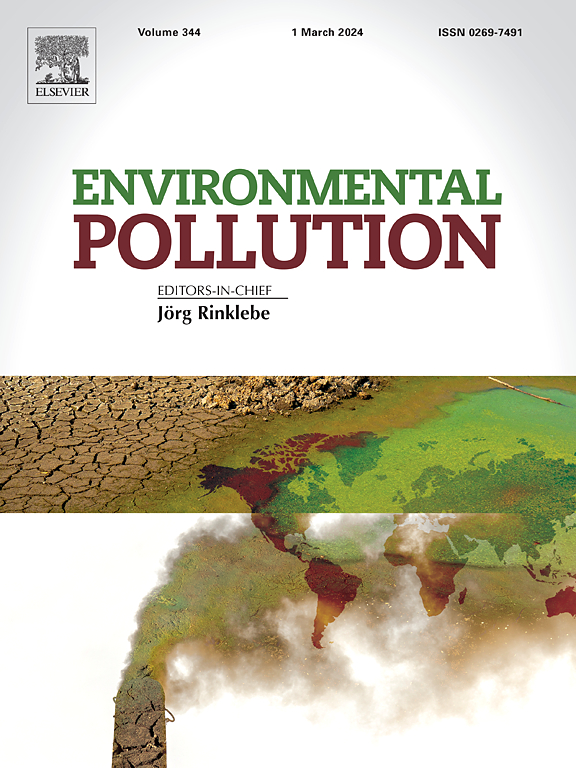Antagonism or synergism? Contrasting toxicity mechanisms of combined antibiotic and metal pollution on Eisenia Fetida
IF 7.6
2区 环境科学与生态学
Q1 ENVIRONMENTAL SCIENCES
引用次数: 0
Abstract
The pervasive occurrence of combined metal and antibiotic pollution (CMAP) in agricultural soils is increasingly being recognized as a novel threat to ecosystems. However, the toxicity variations of CMAP compared to single pollution and the mechanisms underlying these changes remain poorly understood. Herein in this study, the toxicities of copper (Cu)/erythromycin (ERY) and lead (Pb)/norfloxacin (NOR) to earthworms (Eisenia Fetida) were investigated. These results indicated that a single exposure to ERY and NOR at environmental concentrations had negligible effects on physiological processes. Combined Cu/ERY exposure induced more significant oxidative stress, disrupted energy metabolism, and caused cellular damage than Cu alone, as indicated by altered antioxidant enzyme activities, malondialdehyde and adenosine triphosphate content, elevated reactive oxygen species levels, and apoptosis rates in coelomocytes. Conversely, these adverse effects were mitigated by Pb/NOR exposure compared to Pb treatment alone. Further analysis of the gut microbiota revealed that Cu/Pb-tolerant Bacillus spp. play a critical mediating role in the contrasting toxicity profiles. ERY reduced the abundance of Bacillus spp., diminishing their ability to secrete soluble phosphate to immobilize Cu in the gut and leading to increased Cu absorption and toxicity. NOR enriches Bacillus spp. in the gut, facilitating Pb immobilization and reducing Pb bioavailability and toxicity. The contrast toxicity profile revealed the response of the gut microbiota taxa is the primary determinant of the variation in CMAP toxicity. These findings advance our understanding of the impact of CMAP on soil organisms and highlight the need for comprehensive ecological risk assessments to inform regulatory strategies.

人们日益认识到,农业土壤中普遍存在的金属和抗生素联合污染(CMAP)对生态系统构成了新的威胁。然而,与单一污染相比,CMAP 的毒性变化以及导致这些变化的机制仍然鲜为人知。本研究调查了铜(Cu)/红霉素(ERY)和铅(Pb)/诺氟沙星(NOR)对蚯蚓(Eisenia Fetida)的毒性。结果表明,单一暴露于环境浓度的 ERY 和 NOR 对生理过程的影响微乎其微。与单独接触铜相比,联合接触铜/ERY 会诱发更严重的氧化应激,破坏能量代谢,并造成细胞损伤,表现为抗氧化酶活性、丙二醛和三磷酸腺苷含量的改变、活性氧水平的升高以及腹腔细胞的凋亡率。相反,与单独处理铅相比,暴露于铅/NOR可减轻这些不利影响。对肠道微生物群的进一步分析表明,铜/铅耐受性芽孢杆菌属在对比强烈的毒性特征中起着关键的调解作用。ERY降低了芽孢杆菌属的丰度,削弱了它们分泌可溶性磷酸盐以固定肠道中铜的能力,导致铜的吸收和毒性增加。NOR 增加了肠道中芽孢杆菌的数量,促进了铅的固定,降低了铅的生物利用度和毒性。对比毒性特征显示,肠道微生物群分类群的反应是 CMAP 毒性变化的主要决定因素。这些发现加深了我们对 CMAP 对土壤生物影响的理解,并强调了进行全面生态风险评估的必要性,以便为监管策略提供依据。
本文章由计算机程序翻译,如有差异,请以英文原文为准。
求助全文
约1分钟内获得全文
求助全文
来源期刊

Environmental Pollution
环境科学-环境科学
CiteScore
16.00
自引率
6.70%
发文量
2082
审稿时长
2.9 months
期刊介绍:
Environmental Pollution is an international peer-reviewed journal that publishes high-quality research papers and review articles covering all aspects of environmental pollution and its impacts on ecosystems and human health.
Subject areas include, but are not limited to:
• Sources and occurrences of pollutants that are clearly defined and measured in environmental compartments, food and food-related items, and human bodies;
• Interlinks between contaminant exposure and biological, ecological, and human health effects, including those of climate change;
• Contaminants of emerging concerns (including but not limited to antibiotic resistant microorganisms or genes, microplastics/nanoplastics, electronic wastes, light, and noise) and/or their biological, ecological, or human health effects;
• Laboratory and field studies on the remediation/mitigation of environmental pollution via new techniques and with clear links to biological, ecological, or human health effects;
• Modeling of pollution processes, patterns, or trends that is of clear environmental and/or human health interest;
• New techniques that measure and examine environmental occurrences, transport, behavior, and effects of pollutants within the environment or the laboratory, provided that they can be clearly used to address problems within regional or global environmental compartments.
 求助内容:
求助内容: 应助结果提醒方式:
应助结果提醒方式:


